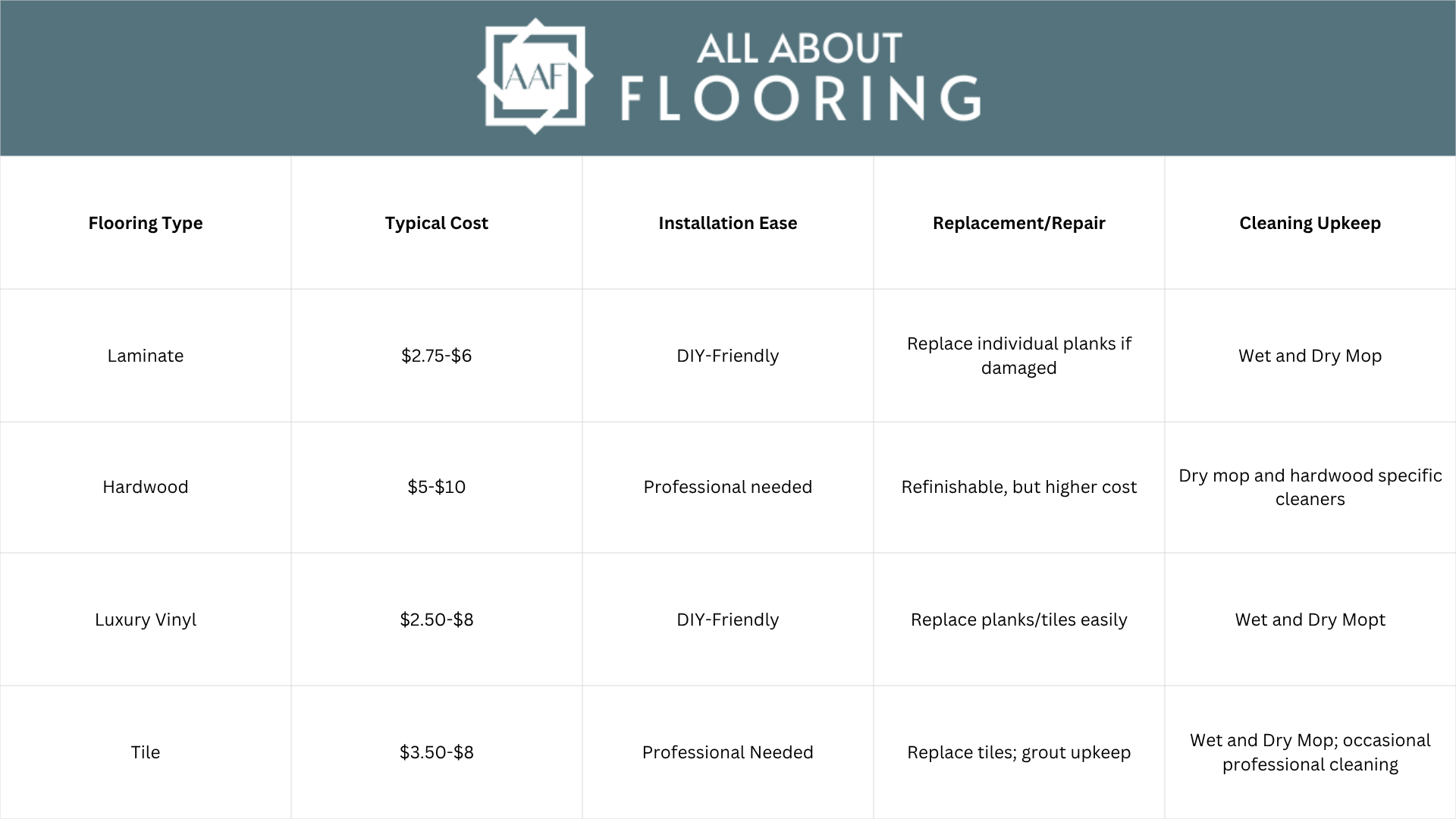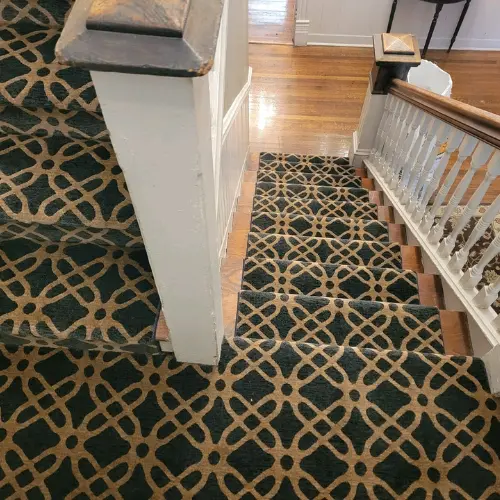What Sets Laminate Flooring Apart from Other Types of Flooring?
Laminate flooring has grown in popularity, but how does it truly differ from vinyl, hardwood, tile, and other options? In this guide, we’ll explore the key features, benefits, and considerations that make laminate stand out—and help you determine if it’s the best choice for your home.
.webp)
Why Choose Laminate Flooring?
- Affordability: Typically more budget-friendly than solid hardwood or premium tile.
- Realistic Appearance: Advanced printing technologies mimic wood, stone, and tile visuals convincingly. To learn a little bit more about the rustic look laminate can give, check out our blog on the Best Floors for the “Farmhouse Look” here.
- Durability: Scratch-resistant wear layer suits pets, kids, and busy households.
- Ease of Installation: Click-lock systems often allow DIY installation or faster professional install.
- Low Maintenance: Simple sweeping and damp mopping without special cleaners.
- Versatility: Available in many colors, textures, and plank widths to fit diverse design styles.
Laminate vs. Other Popular Flooring Types
1. Laminate vs. Hardwood
- Appearance & Feel
- Laminate: Printed image layer imitates wood; the surface is durable but not authentic wood grain.
- Hardwood: Genuine wood planks offer natural grain, warmth, and potential to refinish.
- Laminate: Printed image layer imitates wood; the surface is durable but not authentic wood grain.
- Cost
- Laminate: Generally lower upfront cost per square foot.
- Hardwood: Higher material and installation costs; refinishing adds future expense.
- Laminate: Generally lower upfront cost per square foot.
- Durability & Maintenance
- Laminate: Wear layer resists scratches and dents; moisture resistance varies—select water-resistant laminate for kitchens.
- Hardwood: Prone to scratches and water damage; needs periodic refinishing and careful cleaning.
- Laminate: Wear layer resists scratches and dents; moisture resistance varies—select water-resistant laminate for kitchens.
- Installation
- Laminate: Click-lock floating installation over underlayment; suitable for DIY or quicker professional work.
- Hardwood: Nail-down or glue-down; usually requires professional installers.
- Laminate: Click-lock floating installation over underlayment; suitable for DIY or quicker professional work.
- Lifespan
- Laminate: Modern laminate can last 15–25 years depending on quality and wear layer thickness.
- Hardwood: 30+ years with refinishing but sensitive to moisture and heavy traffic if not maintained properly.
- Laminate: Modern laminate can last 15–25 years depending on quality and wear layer thickness.
2. Laminate vs. Luxury Vinyl (LVP/LVT)
- Water Resistance
- Laminate: Many types are water-resistant, but not all are fully waterproof—check manufacturer specs for bathrooms or basements.
- Luxury Vinyl: Most options are 100% waterproof, making them preferable for bathrooms, kitchens, and laundry rooms.
- Laminate: Many types are water-resistant, but not all are fully waterproof—check manufacturer specs for bathrooms or basements.
- Comfort & Underfoot Feel
- Laminate: Feels firmer underfoot; underlayment can add some cushioning and sound reduction.
- Vinyl: Often softer and warmer underfoot; some rigid core vinyl (WPC/SPC) adds stability and comfort.
- Laminate: Feels firmer underfoot; underlayment can add some cushioning and sound reduction.
- Appearance
- Laminate: High-definition prints mimic wood or stone but may lack the texture realism of high-end vinyl or actual hardwood.
- Vinyl: Textured surfaces can replicate embossing in register (EIR) for more realistic wood grain or stone texture.
- Laminate: High-definition prints mimic wood or stone but may lack the texture realism of high-end vinyl or actual hardwood.
- Installation & Repairs
- Both use click-lock systems; damaged laminate planks can be swapped, as can vinyl planks/tiles.
- Vinyl’s waterproof nature often gives it an edge in moisture-prone areas.
- Both use click-lock systems; damaged laminate planks can be swapped, as can vinyl planks/tiles.
3. Laminate vs. Tile (Porcelain/Ceramic)
- Water & Stain Resistance
- Laminate: Water-resistant varieties exist, but grout-free laminate avoids grout upkeep.
- Tile: Naturally waterproof and stain-resistant; grout lines require sealing and occasional deep cleaning.
- Laminate: Water-resistant varieties exist, but grout-free laminate avoids grout upkeep.
- Durability
- Laminate: Good scratch resistance; can fade over many years in direct sunlight.
- Tile: Extremely durable against scratches; can crack if heavy objects drop; grout can discolor without maintenance.
- Laminate: Good scratch resistance; can fade over many years in direct sunlight.
- Comfort & Warmth
- Laminate: Warmer underfoot than tile; underlayment adds insulation and noise reduction.
- Tile: Cooler surface—may feel cold without radiant heat; ideal for hot climates.
- Laminate: Warmer underfoot than tile; underlayment adds insulation and noise reduction.
- Style Options
- Laminate: Wide variety of wood- and stone-look planks.
- Tile: Vast design possibilities—patterns, shapes, mosaics, and natural stone looks.
- Laminate: Wide variety of wood- and stone-look planks.
4. Laminate vs. Engineered Wood
- Surface Material
- Laminate: High-resolution image layer over composite core.
- Engineered Wood: Thin layer of real wood veneer over plywood or HDF core.
- Laminate: High-resolution image layer over composite core.
- Authenticity & Refinishing
- Laminate: Cannot be refinished; once wear layer is worn, replacement is needed.
- Engineered Wood: Can be refinished a limited number of times if veneer thickness allows.
- Laminate: Cannot be refinished; once wear layer is worn, replacement is needed.
- Cost
- Laminate: Usually less expensive than engineered wood.
- Engineered Wood: Higher cost but offers real wood benefits.
- Laminate: Usually less expensive than engineered wood.
- Moisture Tolerance
- Laminate: Water-resistant types available; not always fully waterproof.
- Engineered Wood: More stable than solid hardwood, but still sensitive to moisture compared to laminate or vinyl.
- Laminate: Water-resistant types available; not always fully waterproof.
Key Features That Differentiate Laminate Flooring
- Multi-Layer Construction
- Wear Layer: Transparent, scratch-resistant layer protects against daily wear.
- Design Layer: High-definition printed image replicates wood, stone, or tile patterns.
- Core Layer: High-density fiberboard (HDF) offers stability and strength.
- Underlayment Layer (optional/integrated): Provides sound reduction, moisture barrier, and cushioning.
- Wear Layer: Transparent, scratch-resistant layer protects against daily wear.
- Thickness & Wear Rating
- Typical thickness ranges from 6mm to 12mm+. Thicker planks often feel more solid and handle uneven subfloors better.
- AC rating (Abrasion Criteria) indicates durability: AC3+ for residential; AC4+ for heavier traffic. Aim for AC4 for busy homes.
- Typical thickness ranges from 6mm to 12mm+. Thicker planks often feel more solid and handle uneven subfloors better.
- Click-Lock Installation
- Floating floor installation means planks lock together without glue or nails.
- Faster install and easier replacements of individual planks if damaged.
- Floating floor installation means planks lock together without glue or nails.
- Design Variety
- Extensive catalog of wood species looks (oak, maple, hickory), stone textures, and modern patterns like wide planks or gray tones.
- Some brands offer embossed or textured surfaces to mimic real wood grain depth.
- Extensive catalog of wood species looks (oak, maple, hickory), stone textures, and modern patterns like wide planks or gray tones.
- Underlayment Compatibility
- Many laminate products include attached underlayment or require a separate underlayment for moisture barrier and acoustic comfort.
- Underlayment choice can impact feel, sound, and thermal insulation.
- Many laminate products include attached underlayment or require a separate underlayment for moisture barrier and acoustic comfort.
- Environmental Considerations
- Many laminated cores are made from recycled wood fibers; some products carry sustainability certifications.
- Low-VOC adhesives and finishes contribute to healthier indoor air quality.
- Many laminated cores are made from recycled wood fibers; some products carry sustainability certifications.
Ideal Use Cases for Laminate Flooring
- Living Rooms & Bedrooms: Offers wood-like appearance with easy upkeep.
- Home Offices: Professional look without high cost; easy to clean.
- Hallways & Entryways: Durable wear layer handles foot traffic; pair with durable underlayment to reduce noise.
- Kitchens (with Caution): Use water-resistant laminate and manage spills promptly; consider vinyl or tile if prone to heavy moisture.
- Basements: Only if rated for moisture conditions; alternatively, choose waterproof vinyl for below-grade spaces.
- Rental Properties: Cost-effective, durable, and quick to install or replace between tenants.
To get some inspiration, see some of our latest laminate projects here.
Maintenance & Care for Laminate Flooring
- Regular Cleaning: Sweep or vacuum (soft brush head) to remove dirt/grit.
- Mopping: Use a damp (not wet) mop with manufacturer-recommended cleaner. Avoid excessive water which can seep into seams.
- Spill Management: Wipe up liquids immediately to prevent swelling of the core.
- Protective Measures: Use felt pads under furniture legs; place mats at entryways; avoid dragging heavy items.
- Sunlight Exposure: Use blinds or UV-protective window film if direct sun may fade the printed layer over years.
Cost Comparison Snapshot of Laminate Compared to Other Flooring

Ready to Explore Laminate Flooring?
Laminate offers style, durability, and affordability in one package. At All About Flooring, we can help you choose the right laminate product, show you samples in our Greenville, SC showroom, and provide professional installation. If you need help finding the right color and style, take one of our flooring quizzes here.





